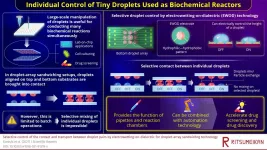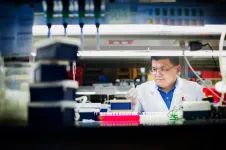(Press-News.org) ITHACA, N.Y. - An interdisciplinary team of Cornell and Harvard University researchers developed a machine learning tool to parse quantum matter and make crucial distinctions in the data, an approach that will help scientists unravel the most confounding phenomena in the subatomic realm.
The Cornell-led project's paper, "Correlator Convolutional Neural Networks as an Interpretable Architecture for Image-like Quantum Matter Data," published June 23 in Nature Communications. The lead author is doctoral student Cole Miles.
The Cornell team was led by Eun-Ah Kim, professor of physics in the College of Arts and Sciences, who partnered with Kilian Weinberger, associate professor of computing and information science in the Cornell Ann S. Bowers College of Computing and Information Science and director of the TRIPODS Center for Data Science for Improved Decision Making.
The collaboration with the Harvard team, led by physics professor Markus Greiner, is part of the National Science Foundation's 10 Big Ideas initiative, "Harnessing the Data Revolution." Their project, "Collaborative Research: Understanding Subatomic-Scale Quantum Matter Data Using Machine Learning Tools," seeks to address fundamental questions at the frontiers of science and engineering by pairing data scientists with researchers who specialize in traditional areas of physics, chemistry and engineering.
The project's central aim is to find ways to extract new information about quantum systems from snapshots of image-like data. To that end, they are developing machine learning tools that can identify relationships among microscopic properties in the data that otherwise would be impossible to determine at that scale.
Convolutional neural networks, a kind of machine learning often used to analyze visual imagery, scan an image with a filter to find characteristic features in the data irrespective of where they occur - a step called "convolution." The convolution is then sent through nonlinear functions that make the convolutional neural networks learn all sorts of correlations among the features.
Now, the Cornell group has improved upon that approach by creating an "interpretable architecture," called Correlation Convolutional Neural Networks (CCNN), that allows the researchers to track which particular correlations matter the most.
"Convolutional neural networks are versatile," Kim said. "However, the versatility that comes from the nonlinearity makes it difficult to figure out how the neural network used a particular filter to make its decision, because nonlinear functions are hard to track. That's why weather prediction is difficult. It's a very nonlinear system."
To test CCNN, the Harvard team employed quantum gas microscopy to simulate a fermionic Hubbard model - often used to demonstrate how quantum particles interact in a lattice, and also the many unresolved questions that are raised as a result.
"Quantum mechanics is probabilistic, but you cannot learn probability from one measurement, you have to repeat many measurements," Kim said. "From the Schrödinger's cat perspective, we have a whole collection of atoms, a collection of live or dead cats. And each time we make a projective measurement, we have some dead cats and some live cats. And from that we're trying to understand what state the system is in, and the system is trying to simulate fundamental models that hold keys to understanding mysterious phenomena, such as high-temperature superconductivity."
The Harvard team generated synthetic data for two states that are difficult to tell apart: geometric string theory and pi-flux theory. In geometric string theory, the system verges on an antiferromagnetic order, in which the electron spins form a kind of anti-alignment - i.e., up, down, up, down, up, down - that is disrupted when an electron hole starts to move at a different timescale. In pi-flux theory, the spins form pairs, called singlets, that begin to flip and flop around when a hole is introduced, resulting in a scrambled state.
CCNN was able to distinguish between the two simulations by identifying correlations in the data to the fourth order.
By repeating this exercise, the CCNN essentially learns what occurrences in the image were essential for neural networks to make a decision - a process that Kim compares to the choices made by people boarding a lifeboat.
"You know when a big ship is about to sink, and people are told, OK, you can only bring one personal item," Kim said. "That will show what's in their hearts. It could be a wedding ring, it could be a trash can. You never know. We're forcing the neural network to choose one or two features that help it the most in coming up with the right assessment. And by doing so we can figure out what are the critical aspects, the core essence, of what defines a state or phase."
The approach can be applied to other scanning probe microscopies that generate image-type data on quantum materials, as well as programmable quantum simulators. The next step, according to Kim, is to incorporate a form of unsupervised machine learning that can offer a more objective perspective, one that is less influenced by the decisions of researchers handpicking which samples to compare.
Kim sees researchers like her student and lead author Cole Miles as representing the next generation that will meld these cutting-edge and traditional approaches even further to drive new scientific discovery.
"More conservative people are skeptical of new and shiny things," Kim said. "But I think that balance and synergy between classic and the new and shiny can lead to nontrivial and exciting progress. And I think of our paper as an example of that."
INFORMATION:
Co-authors include doctoral student Ruihan Wu and researchers from Harvard.
The research was supported by the U.S. Department of Energy, the National Science Foundation and Germany's Excellence Strategy.
When you insist you're not racist, you may unwittingly be sending the opposite message.
That's the conclusion of a new study* by three Berkeley Haas researchers who conducted experiments with white participants claiming to hold egalitarian views. After asking them to write statements explaining why they weren't prejudiced against Black people, they found that other white people could nevertheless gauge the writers' underlying prejudice.
"Americans almost universally espouse egalitarianism and wish to see themselves as non-biased, yet racial prejudice persists," says Berkeley ...
A genetic map of an aggressive childhood brain tumour called medulloblastoma has helped researchers identify a new generation anti-cancer drug that can be repurposed as an effective treatment for the disease.
This international collaboration, led by researchers from The University of Queensland's (UQ) Diamantina Institute and WEHI in Melbourne, could give parents hope in the fight against the most common and fatal brain cancer in children.
UQ lead researcher Dr Laura Genovesi said the team had mapped the genetics of these aggressive brain tumours for five years to find new pathways that existing drugs could potentially target.
"These are drugs already approved for other diseases or cancers but have never been tested in paediatric brain tumours," Dr Genovesi ...
ST. LOUIS -- In the United States, low-income and minority students are completing college at low rates compared to higher-income and majority peers -- a detriment to reducing economic inequality. Double-dose algebra could be a solution, according to a new study published in roceedings of the National Academy of Sciences of the United States of America (PNAS).
The paper, "Effects of Double-Dose Algebra on College Persistence and Degree Attainment," is the culmination of a series of studies that followed two cohorts of ninth-grade students over a period of 12 years in the Chicago Public Schools (CPS) where double-dose algebra ...
Miniaturization is rapidly reshaping the field of biochemistry, with emerging technologies such as microfluidics and "lab-on-a-chip" devices taking the world by storm. Chemical reactions that were normally conducted in flasks and tubes can now be carried out within tiny water droplets not larger than a few millionths of a liter. Particularly, in droplet-array sandwiching techniques, such tiny droplets are orderly laid out on two parallel flat surfaces opposite to each other. By bringing the top surface close enough to the bottom one, each top droplet makes contact with the opposite bottom droplet, exchanging chemicals and transferring particles or even cells. In quite a literal way, these droplets can act as small reaction ...
BUFFALO, N.Y -- Children who eat slower are less likely to be extroverted and impulsive, according to a new study co-led by the University at Buffalo and Children's Hospital of Philadelphia.
The research, which sought to uncover the relationship between temperament and eating behaviors in early childhood, also found that kids who were highly responsive to external food cues (the urge to eat when food is seen, smelled or tasted) were more likely to experience frustration and discomfort and have difficulties self-soothing.
These findings are critical because faster eating and greater responsiveness to food cues have been linked to obesity risk in children, ...
A new study examining why young South Asian heart attack patients have more adverse outcomes found this patient population was often obese, used tobacco products, and had a family history of heart disease or risk factors that could have been prevented, monitored for or treated before heart attacks happen. The study will be presented at the ACC Asia 2021 Together with SCS 32nd Annual Scientific Meeting Virtual being held July 9-11, 2021.
"South Asians tend to have multiple co-morbidities including diabetes and obesity at younger ages which is different from the white population," said Salik ur Rehman Iqbal, ...
Research conducted at Cruzeiro do Sul University in São Paulo, Brazil, can contribute to earlier diagnosis of diabetic neuropathy, a disorder characterized by damage to peripheral nerves, with symptoms such as pain and paresthesia (pricking, burning and numbness), mainly in the legs and feet.
In the study, a group led by Professor Paulo Barbosa de Freitas Júnior measured grip force in diabetic patients while they were holding and handling objects. The results were compared with data for healthy subjects and patients with other neurological diseases, such as multiple sclerosis, Parkinson’s, and carpal tunnel syndrome (pain, numbness and tingling in the hand and arm caused by a pinched nerve in the wrist).
Freitas and his ...
July 7, 2021 - The murders of George Floyd and other Black Americans have prompted a national outcry against structural racism and police brutality. How are leading nursing organizations and schools of nursing defining their positions on racism? That's the topic of a special article in the July/August issue of The Journal of the Association of Nurses in AIDS Care (JANAC). The official journal of the Association of Nurses in AIDS Care, JANAC is published in the Lippincott portfolio by Wolters Kluwer.
Three major national nursing organizations and many top-ranked schools ...
Colorado researchers have published new findings in Emerging Infectious Diseases that take a first look at the use of SARS-CoV-2 mathematical modeling to inform early statewide policies enacted to reduce the spread of the Coronavirus pandemic in Colorado. Among other findings, the authors estimate that 97 percent of potential hospitalizations across the state in the early months of the pandemic were avoided as a result of social distancing and other transmission-reducing activities such as mask wearing and social isolation of symptomatic individuals.
The modeling team was led by faculty and researchers in the Colorado School of Public Health and involved experts from the University of Colorado Anschutz Medical Campus, University of Colorado Denver, University of Colorado ...
Immunologists at St. Jude Children's Research Hospital have identified a biological pathway that selectively controls how key immune cells, called T follicular helper cells, mature into functional components of the immune system.
The finding offers the promise of developing drugs to activate the metabolic pathway to enhance the effectiveness of vaccines, including those that protect against COVID-19. Such medications could stimulate the immune system to respond more vigorously following immunization to produce more antibodies against a virus or bacterium.
The work also lays the foundation for drugs that dial down the pathway to alleviate autoimmune diseases such as lupus. In such disorders, an overactive immune system produces antibodies that attack the body's own tissues.
Led by ...




